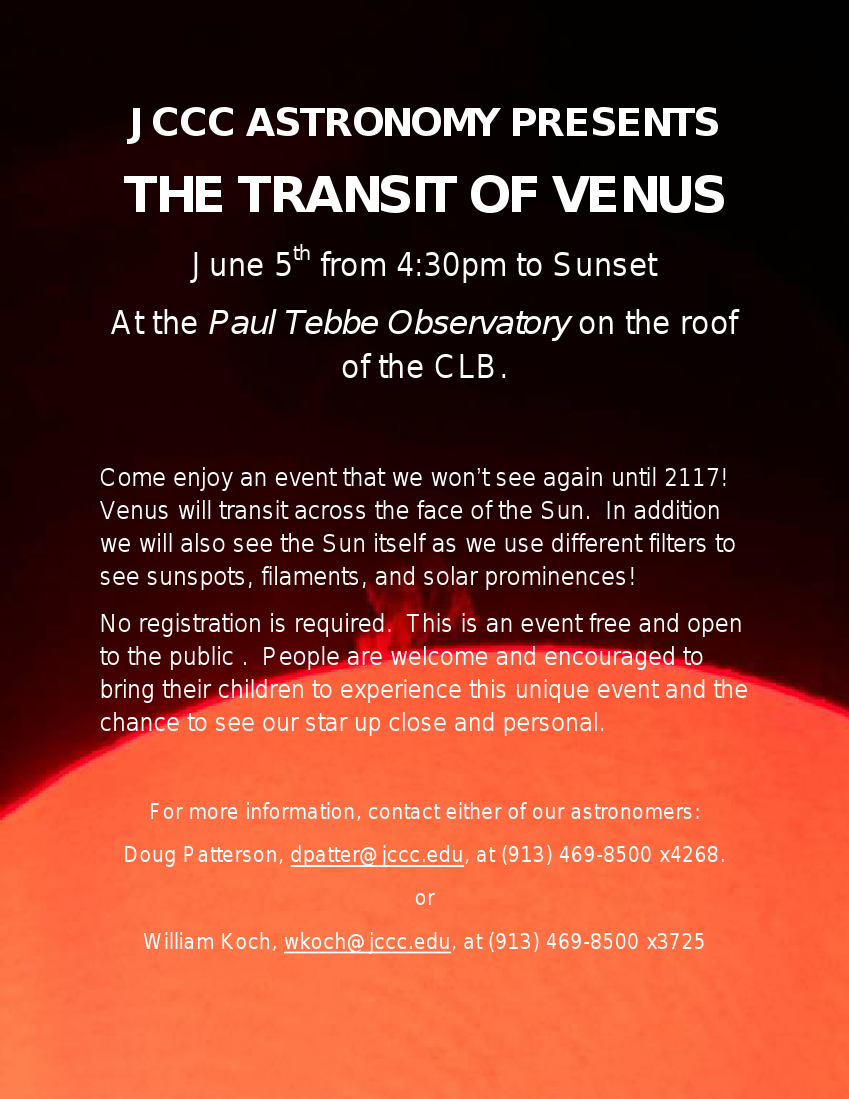Learn more about the history of planetary transits, and about this year’s transit of Venus at http://www.transitofvenus.org/.
All posts by dpatter
Evening With The Stars
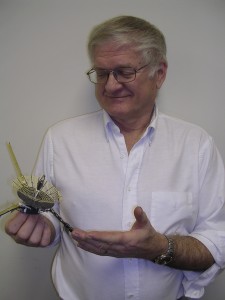 The JCCC Science Division presents an EVENING WITH THE STARS to be held on April 28th at 7:00pm in the Craig Auditorium, GEB 233.
The JCCC Science Division presents an EVENING WITH THE STARS to be held on April 28th at 7:00pm in the Craig Auditorium, GEB 233.
Dr. Thomas Armstrong, Retired Professor of Physics from the University of Kansas and Principle Scientist at Fundamental Technologies, LLC, will give a talk on the history of space exploration, Human History in Space, looking at the major events in space exploration and discoveries that shape our understanding of Earth, the Solar System, the Galaxy, and the Universe as well as discussing presently understood challenges and opportunities in space for present and future generations.
After the talk and weather permitting, we will have several telescopes set up to observe the night-sky at the Paul Tebbe Observatory on the roof of the CLB. Some objects of note that will be viewable are:

- The Orion Nebula
- The Beehive Cluster
- Mars
- Jupiter
- and the Moon.
For more information, contact either William Koch, wkoch@jccc.edu, at (913) 469-8500 x3725, or Doug Patterson, dpatter@jccc.edu, at (913).
Lunar Eclipse Photos
This morning we got to experience a lunar eclipse! Unfortunately, the eclipse began as the Moon was setting, so we didn’t get to see the entire eclipse, just the beginning.
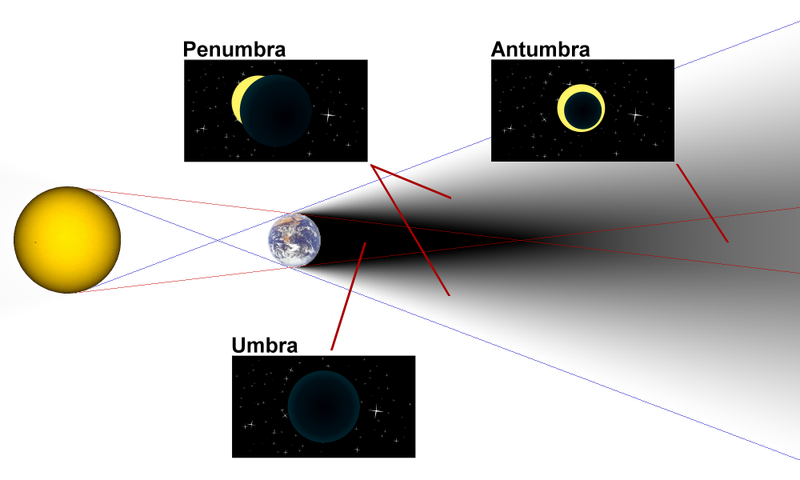
Mystery of the Lunar Ionosphere
If you take an introductory course in Astronomy, such as the ASTR 120 or ASTR 122 courses here at JCCC, you’ll learn that the Moon is airless, that it has no atmosphere. As with most things in astronomy, and science in general, that statement is more or less correct, but when you examine the Moon more closely, there are a lot of complications that arise. The Moon doesn’t really have an atmosphere in the traditional sense, but that doesn’t mean that it’s completely devoid of a shroud of gas. Recently, more information has been discovered about the Moon’s ionosphere, something that shouldn’t exist for an airless world. Check out this video from Science@NASA for the details.
NASA Sets Mars Science Laboratory Launch Coverage
We headed back to Mars! This time, the new Mars rover, Curiosity, will be better equipped to discover signs of Martian life, either current or from the past. One of the things that NASA has been doing very well as of late is to promote its new launches and make video of those launches available through a wide variety of outlets. Most cable and satellite TV providers have NASA TV as part of their basic package, but if you don’t have NASA TV at home, you can always stream it from their website at http://www.nasa.gov/multimedia/nasatv/. Below is the official press release from NASA about the upcoming launch and details about pre-launch press conferences discussing the mission.
NASA Sets Mars Science Laboratory Launch Coverage
PASADENA, Calif. — NASA’s Mars Science Laboratory spacecraft with the Curiosity rover is set to launch to the planet Mars aboard an Atlas V rocket on Nov. 25, 2011 from Space Launch Complex 41 at Cape Canaveral Air Force Station in Florida. The launch window extends from 10:25 a.m. to 12:08 p.m. EST (7:25 a.m. to 9:08 a.m. PST). The launch period for the mission extends through Dec. 18.
The spacecraft will arrive at Mars in August 2012. Curiosity has 10 science instruments to search for evidence about whether Mars had environments favorable for microbial life, including the chemical ingredients for life. The unique rover will use a laser to look inside rocks and release their gasses so that a spectrometer can analyze them and send the data back to Earth.
Briefings about the mission are scheduled throughout the week leading to launch and will be held at the Kennedy Space Center’s Press Site.
Science Briefings and Prelaunch News Conference
Monday, Nov. 21, 1 p.m. EST (10 a.m. PST): “What Do We Know About Mars?”
Participants will be:
Michael Meyer, lead scientist, Mars Exploration Program
NASA Headquarters, Washington
John Grotzinger, project scientist, Mars Science Laboratory
California Institute of Technology, Pasadena, Calif.
Bethany Ehlmann, scientist, NASA Jet Propulsion Laboratory, Pasadena, Calif.
Assistant professor, California Institute of Technology, Pasadena, Calif.
Tuesday, Nov. 22, 11 a.m. EST (8 a.m. PST): “Looking for Signs of Life in the Universe”
Participants will be:
Mary Voytek, director, Astrobiology Program
NASA Headquarters, Washington
Jamie Foster, professor, Department of Microbiology and Cell Science
University of Florida, Gainesville
Pan Conrad, deputy principal investigator, Sample Analysis at Mars, Mars Science Laboratory
NASA Goddard Space Flight Center, Greenbelt, Md.
Steven Benner, director, Foundation for Applied Molecular Evolution
Gainesville, Fla.
Catharine Conley, planetary protection officer
NASA Headquarters, Washington
Tuesday, Nov. 22, 1 p.m. EST (10 a.m. PST): Prelaunch News Conference
Participants will be:
Colleen Hartman, assistant associate administrator, Science Mission Directorate
NASA Headquarters, Washington
Omar Baez, NASA launch director
NASA’s Kennedy Space Center, Cape Canaveral, Fla.
Vernon Thorp, program manager, NASA Missions
United Launch Alliance, Denver
Peter Theisinger, Mars Science Laboratory project manager
NASA Jet Propulsion Laboratory, Pasadena, Calif.
Clay Flinn, launch weather officer
45th Weather Squadron, Cape Canaveral Air Force Station, Fla.
Curiosity Mission Science Briefing: This briefing will immediately follow the prelaunch news conference. Participants will be:
Michael Meyer, lead scientist for Mars Exploration Program
NASA Headquarters, Washington
John Grotzinger, project scientist for Mars Science Laboratory
California Institute of Technology, Pasadena, Calif.
Paul Mahaffy, principal investigator for Sample Analysis at Mars investigation on Curiosity
NASA Goddard Space Flight Center, Greenbelt, Md.
David Blake, principal investigator for Chemistry and Mineralogy investigation on Curiosity
NASA Ames Research Center, Moffett Field, Calif.
Michael Malin, principal investigator for the Mast Camera and Mars Descent Imager investigations on Curiosity
Malin Space Science Systems, San Diego
Roger Wiens, principal investigator for Chemistry and Camera investigation on Curiosity
Los Alamos National Laboratory, Los Alamos, N.M.
Wednesday, Nov. 23, 1 p.m. EST (10 a.m. PST): “Why Mars Excites and Inspires Us”
Participants will be:
Leland Melvin, associate administrator for Education
NASA Headquarters, Washington
Scott Anderson, teacher and science department chairman
Da Vinci School for Science & the Arts, El Paso, Texas
Clara Ma, student, NASA contest winner for naming Curiosity
Shawnee Mission East High School, Prairie Village, Kansas
Veronica McGregor, manager, Media Relations Office
NASA Jet Propulsion Laboratory, Pasadena, Calif.
Wednesday, Nov. 23, 2 p.m. EST (11 a.m. PST): “Missions to Mars: Robotics and Humans Together”
(Originating from NASA’s Johnson Space Center, Houston)
Doug Ming, manager, Human Exploration Science Office; Mars Science Laboratory Co-Investigator
NASA Johnson Space Center, Houston
Bret Drake, deputy chief architect, Human Spaceflight Architecture Team
NASA Johnson Space Center, Houston
Matt Ondler, assistant director, Advanced Project Development
NASA Johnson Space Center, Houston
Mike Gernhardt, NASA astronaut
NASA Johnson Space Center, Houston
John Charles, program scientist, Human Research Program
NASA Johnson Space Center, Houston
A post-launch news conference will be held at the NASA News Center approximately 2 ½ hours after launch.
NASA Television Launch Coverage
On Friday, Nov. 25, NASA Television coverage of the launch will begin at 8 a.m. EST (5 a.m. PST) and conclude after spacecraft separation from the Atlas V occurs 53 minutes, 49 seconds after launch. Live launch coverage will be carried on all NASA Television channels.
A post-launch news conference will be held at the Kennedy press site approximately 2 ½ hours after launch.
For NASA Television downlink information, schedule information and streaming video, visit: http://www.nasa.gov/ntv .
Launch coverage also will be available on local amateur VHF radio frequency 146.940 MHz broadcast within Brevard County.
Ustream Coverage
The Mars Science Laboratory news conferences, briefings and launch will be streamed live on Ustream at http://www.ustream.tv/nasajpl .
NASA Web Coverage
Extensive prelaunch and launch day coverage of the liftoff of the Mars Science Laboratory spacecraft aboard an Atlas V rocket will be available on NASA’s home page on the Internet at: http://www.nasa.gov .
A prelaunch webcast for the mission will be streamed on the Web on Wednesday, Nov. 22, at noon EST (9 a.m. PST). Live countdown coverage through NASA’s Launch Blog begins at 8 a.m. EST (5 a.m. PST) on Friday, Nov. 25. Coverage features live updates as countdown milestones occur, as well as streaming video clips highlighting launch preparations and liftoff.
To view the webcast and the blog or to learn more about Mars Science Laboratory, visit the mission home page at: http://www.nasa.gov/msl and http://mars.jpl.nasa.gov/msl .
Twitter
The NASA News Twitter feed will be updated throughout the launch countdown. You can follow the updates at: http://www.twitter.com/nasa and http://www.twitter.com/nasakennedy and http://www.twitter.com/nasajpl .
NASA’s Jet Propulsion Laboratory, Pasadena, Calif., a division of the California Institute of Technology, manages the Mars Science Laboratory mission. Launch management is the responsibility of NASA’s Launch Services Program at the Kennedy Space Center in Florida. The Atlas V launch service is provided by United Launch Alliance, Denver.
The full version of this story with accompanying images is at:
http://www.jpl.nasa.gov/news/news.cfm?release=2011-349b&cid=release_2011-349b
The Lunar Reconnaissance Orbiter Images Apollo Landing Sites
Not that this will stop the conspiracy theorists who insist that Apollo happened on a soundstage, but for the rest of us, this is pretty darn cool! The Lunar Reconnaissance Orbiter (LRO) is in a very low orbit around the Moon, and using its hi-resolution camera it was able to capture images of the Apollo 12, 14, and 17 landing sites. You can see the equipment left on the surface, rover tracks, and foot paths left by the Apollo astronauts.
Clouds were no impediment to the ISS crew from viewing the Perseids
Science@NASA talks about the amazing Perseid meteor imaged from the International Space Station.
Solar Storm Engulfing Earth Imaged by Spacecraft
This is a perfect reason why we need to be focusing more effort into Space Weather research, and especially prediction. The STEREO-A spacecraft imaged a coronal mass ejection (CME) impacting the Earth in December 2008.
You can read more about this event and the potential devastating affects of CME’s at Science@NASA, http://science.nasa.gov/.
Evening With The Stars for Fall 2009
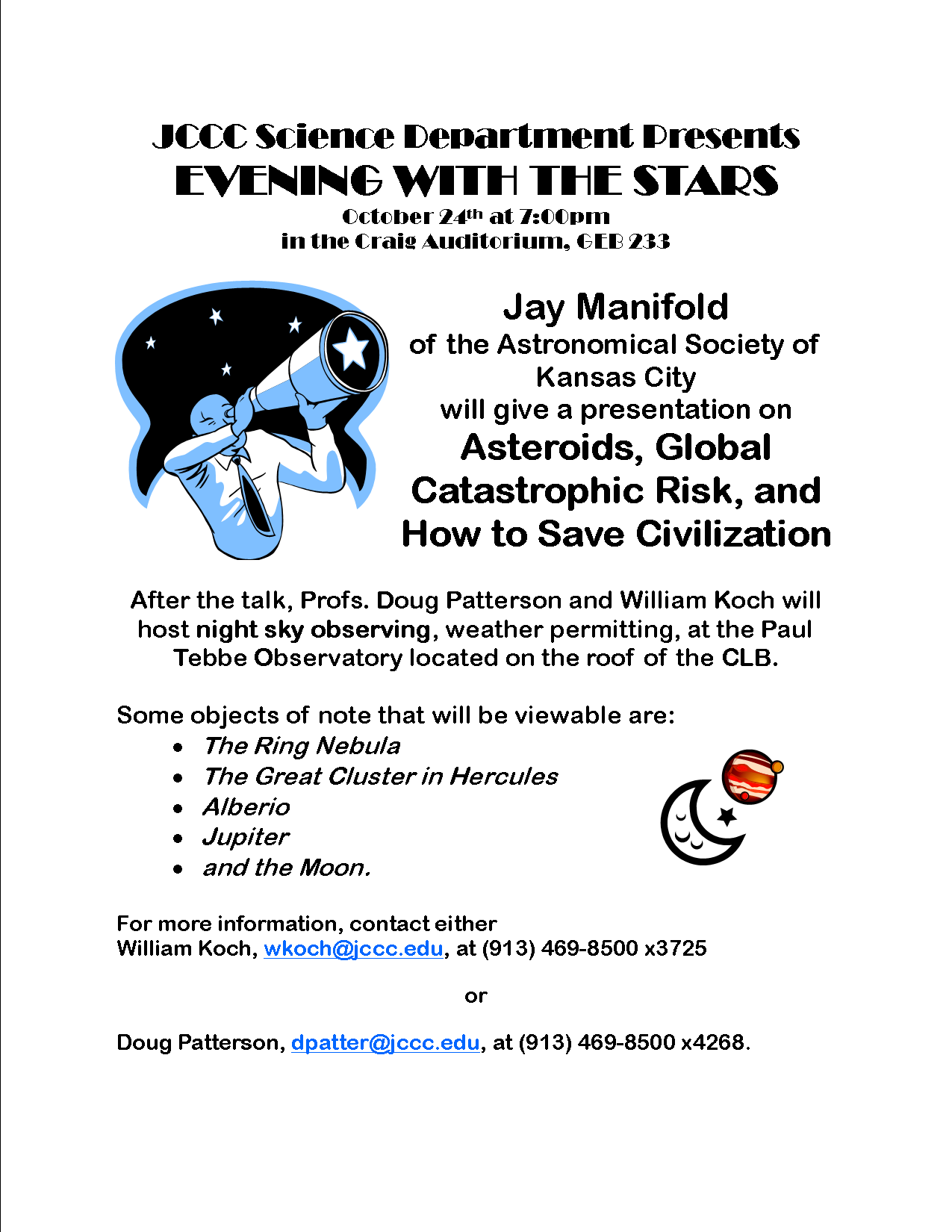
Summer Work
The corn is starting to dry out, so it must be time for the Fall semester to start up again. Here at JCCC, though, the work doesn’t stop just because its Summertime. This past summer term, I had an honors student that worked on astrophotography and differential photometry. Both were fun projects, and I’ll write more about the variable star photometry later. For now, let me show off some of the excellent images G. W. Francis took with our SBIG ST-8 CCD camera and his own Nikon D40.
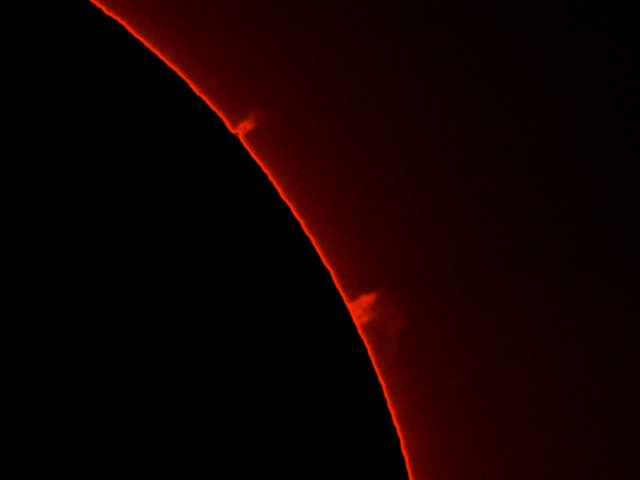
Every Monday evening in June, it seemed, was cloudy, so we decided to take advantage of a sunny afternoon and image the Sun using an H-alpha filter. This filter only allows the one wavelength of red light emitted by hydrogen atoms which enables us to see features like the prominence shown above.
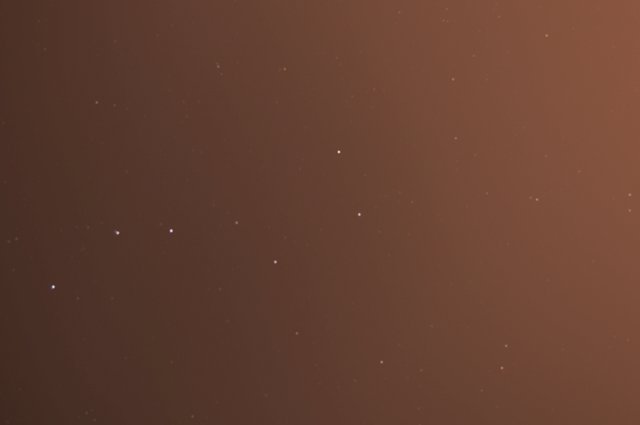
GW mounted his D40 onto the piggyback mount of our Celestron 8″ SC telescope and tried to take an image of the constellation Ursa Major. Most of what he got was the reflected light from the sodium vapor lamps in the parking lot. This was the last night of observing at the college. The light pollution was just too much for us.
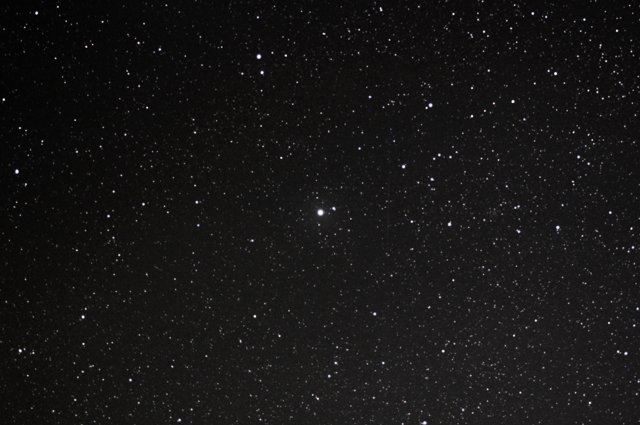
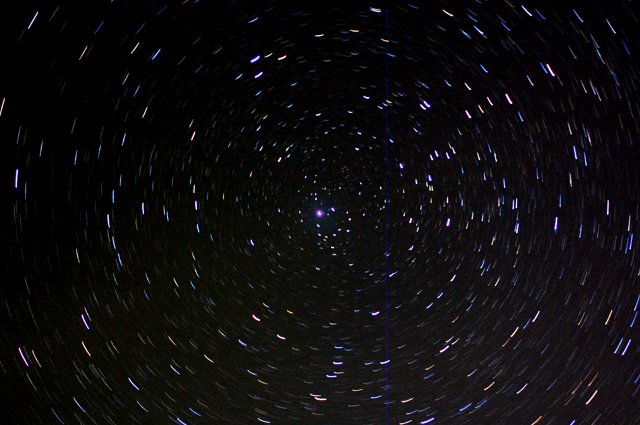
GW mounted his Nikon D40 on a tripod and pointed it northward, centering Polaris in the field of view and collected 21 images each with a 30-sec exposure. By rotating and aligning each image, a detailed view of the Northern Night Sky is revealed. When the images are not rotated, but simply stacked and merged together, the rotation of the Earth becomes apparent as the stars leave trails through the sky. Notice that Polaris, which is very close to the North Celestial Pole, remains nearly fixed in place.
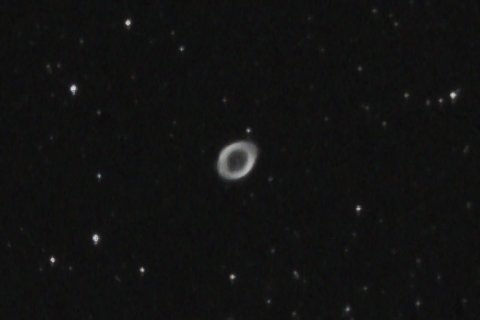
Before settling down onto the program variable star for the evening, the we targeted several Messier objects. M57, the Ring Nebula, is a planetary nebula. A star, not unlike our Sun, threw off its outer layers as it died leaving behind an expanding shell of gas and a small but staggeringly hot white dwarf in the center.
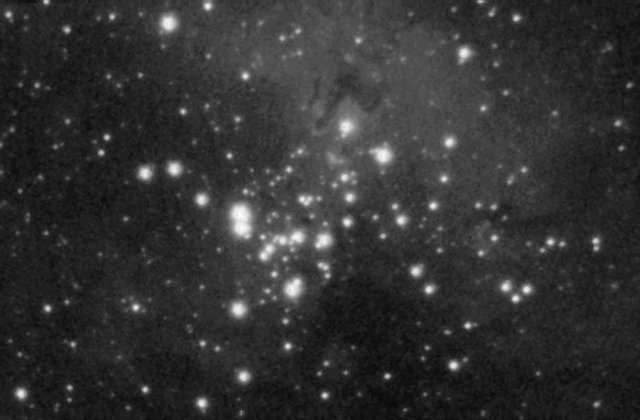
M16, The Eagle Nebula, made famous by the Hubble Telescope’s image Pillars of Creation, had to be imaged by peeking through the gaps in a maple tree near where we had setup the telescope. The location was chosen for optimum viewing of the variable star DY Her, not M16, but we got lucky. In the image you can make out the famous pillars in the top center of the image.
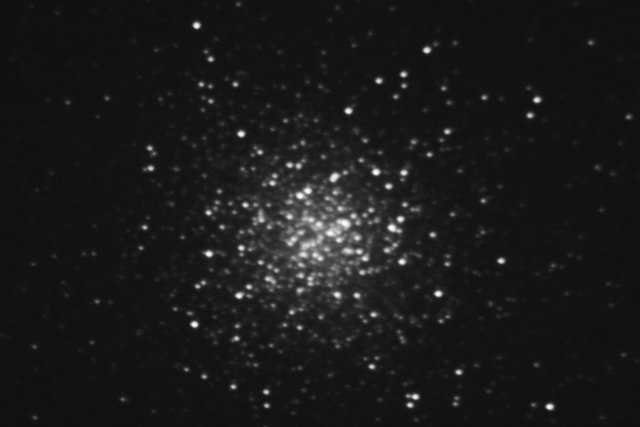
M13, the Great Cluster in Hercules, is one of the closest (relatively speaking) globular clusters to our planet. This dense cluster is home for around a million ancient stars.
